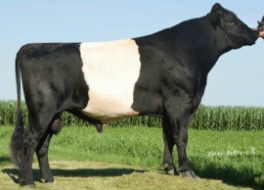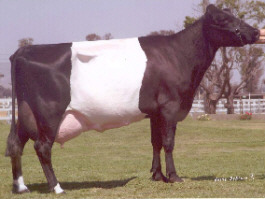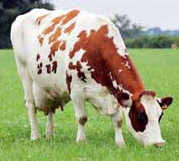



Dutch Belted
History
The Dutch Belted (Lakenvelder) breed traces directly to the original belted cattle which were described in Switzerland and Austria. The breed was then established in the Netherlands in the 17th century. From the records obtainable, it seems they were bred by the nobility who conceived the idea of breeding animals of all kinds to a particular colour, mainly with a band of white in the center and both ends black.The Dutch were very protective of their belted cattle and would generally not part with them. They were highly prized for their milking and fattening abilities. The breed began to flourish in Holland around 1750. (This historical account is found in Professor Raymond Becker's book, Dairy Cattle Breeds: Origin and Development.)
The American Livestock Breeds Conservancy now lists Dutch Belted as on the critically rare breeds of livestock in the North America, with fewer than 200 registered cattle in the country.
 Photo courtesy of The Dutch Belted Cattle Association of America, www.dutchbelted.com |
In 1976, after two and a half decades of cross breeding the original Lakenvelders, the remaining cattle of those herds were only 2% well-marked. Since reintroduction of pure bloodlines via semen from the U.S. in 1990, the national Lakenvelder herd is 57% well-marked.
Dutch Belted have other unique characteristics which make them desirable in crossbreeding programs. Of course, due to the rarity of the pure Dutch Belted crossbreeding can only be recommended by use of Dutch Belted males or semen on common cows, not crossbreeding Dutch Belted females to males of other breeds. Such crossing has been to some extent responsible for the decline in numbers of pure Dutch Belted.
Characteristics
The name Lakenvelder or Lakenfield cattle derives from the word “laken” meaning a sheet or cloth, referring to the white band passing around the body. In some countries animals with this marking are known as “sheeted” cattle. This belt or sheet is of pure white hair extending from the shoulders to the hip bones and should encircle the body completely. The cattle are otherwise black (or occasionally red). In their original form they were horned and primarily a dairy breed – comparing favourably with the Holstein in milk yield. Cows weigh from 900-1500 pounds with bulls bulls weighing 1350-2000 pounds. Their milk tests 3.5 to 5.5 per cent butter fat making it an ideal drinking milk. Dutch Belted are small-boned, making them very easy calving. They have unusual longevity and fertility, high meat yield and friendly dispositions.Statistics
 Photo courtesy of The Dutch Belted Cattle Association of America, www.dutchbelted.com |
- The breed retains excellent grazing ability and forage efficiency.
- Optimum calving interval is an important trait for seasonal dairy production.
- Many cows produce over 20,000 pounds of milk, primarily on forage.
- Longevity reduces replacement costs, and there are many teenage cows still in production.
- Moderate frame size results in high dairy beef yield.
- Heifers breed early and produce a calf every year.
- Conception rate far exceeds the average 2.7 services required for Holsteins.
- An average birth weight of 70 pounds assures calving ease and less postpartum stress.
Comparative
Distribution
The Dutch Belted although still quite rare can be found in the Netherlands, the USA, Canada, Mexico and there are a small number in New Zealand. |
www.embryoplus.com
www.rarebreeds.co.nz
www.dutchbelted.com


